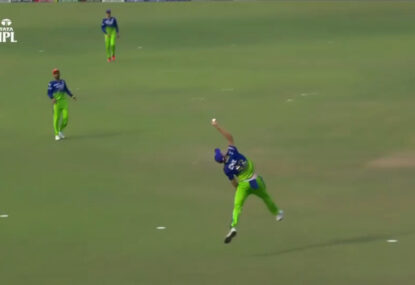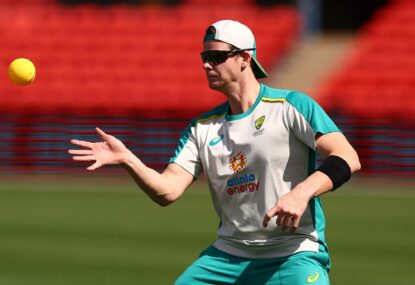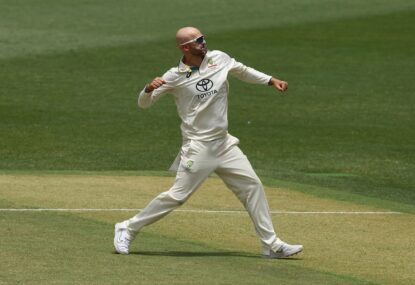Australia cannot be competitive in the World Cup with the level of inflexibility in the current set-up.
This ODI series against India is the perfect opportunity to find the right balance, spread the workload and discover the right tactics that will assist the future of Australian cricket. Even better, it can be done without the non-stop, critical media coverage of a home summer placing pressure on everyone, given the time differences.
Instead we had D’Arcy Short – Australia’s most in-form cricketer – go home before the first ODI because he was only selected as an injury-replacement player, Aaron Finch stay at the top of order despite his woes, and Marcus Stoinis become the much-hyped lynchpin of the team.
Despite Saturday’s series opener heading into the penultimate over, India were comfortable in victory and once again, the lack of thought in Australia’s tactics made an upset win unlikely.
There is absolutely no doubt that D’Arcy Short should open the batting for Australia in the World Cup, and the less time he plays that role on the international stage, the less effective he will be.
Short was the perfect player to take to India, testing his mettle against quality spinners in foreign conditions while also taking full advantage of his bowling.
For a team that has won just four of its last 25 completed ODIs – yes, 25 – it becomes frustrating to see the ability of dangerous players not maximised by the Australian national cricket team.
Other than Short, a player like Chris Lynn seems to have a line through his name at the moment despite his most recent ODI failure against South Africa last November coming when he was thrown into an unfamiliar position at the top of the order. The game before that he finished with a run-a-ball 44 and looked quite good.
Travis Head is playing Sheffield Shield at the moment despite having an average of 34.4 in 42 ODIs and establishing himself as a good contributor in the middle order. Three failures in the home ODI series against South Africa ruled him out, despite his excellent form to finish off the mid-2018 series against England.
It is clear that Aaron Finch is in horrendous form and his spot in the team must be in jeopardy, despite being captain.
A time has come within Australian cricket where ruthless decisions need to be made to ensure a competitive future that doesn’t see Australia losing almost every game and having no chance away from home.
Look at the T20I series win against India. Capitalising on Glenn Maxwell’s form in T20 cricket and batting him up the order was enough to get Australia a win.
If dropping the captain – who is not playing at an international standard at the moment – for a more in-form player, then it should be done.
Marcus Stoinis batting at three was a major change for Australia, however there is little doubt this only came about due to Ashton Turner’s inclusion and the need to bat him down the order. Stoinis has been the talk of the town over the past couple of months and Shane Warne has been campaigning for his inclusion into the Test team for a long time.

(Robert Cianflone/Getty Images)
In the first ODI against India, he batted at three and bowled 9.2 overs. Stoinis is an excellent domestic player in T20 cricket and reasonable in the other two formats, even though the statistics don’t always back him up. He is far from the star of the Australian cricket team, nor is he the man that should be so heavily relied upon in any game.
Australia’s tactical inflexibility stems from pre-arranged plans that don’t seem to change based on game situations. India’s six-wicket win on Saturday was predictable and Australia was never going to win with the bowling tactics employed.
India bowled 27 overs of spin compared to Australia’s 10. Glenn Maxwell is more than capable of bowling a full allotment of overs, and this would have been far more suitable given the conditions. If he bowled poorly, Ashton Turner could also bowl his spin.
Stoinis’ role should be to bat at five or six for Australia and bowl an unspecified amount of overs per game, that shouldn’t be 10 unless he is bowling extremely well. The way he was used in the first ODI screamed Melbourne Stars, and while it may have been effective in a domestic T20 competition against moderate opposition, it doesn’t hold up against arguably the best team in the world on their deck.
Of course, with Marsh, Smith and potentially Warner coming into the team, as well as the return of some key bowlers, we will be seeing drastic changes to the line-up and performances over the coming months.
What this series against India shows us, however, is how Australia will approach games and who the team is willing to trust in certain situations.
At the moment, it doesn’t seem as though Short, Lynn or Head will be trusted to play a role they could probably do better than those currently in the team, while Stoinis seems to be the key factor to Australia’s potential successes in the near future.
The rest of this ODI series will be fascinating to see which players stand up, who is backed in and what tactics are employed by the Australians. We cannot have a repeat of what has happened all summer, and how the team approached the first match against India.
If things don’t change, Australia heads into the World Cup toothless and without direction.




































































































